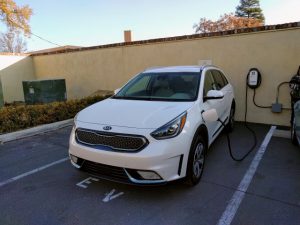Guest Post by Eric Peters

Bad timing is everything.
Try, for example, selling bell-bottom corduroy pants today. Oh, Behave!
In 1977, it was another matter. But it is no longer 1977. Thank god, the government doesn’t (yet) mandate that clothing manufacturers crank out bell-bottom cords on the theory that it is still 1977 – and then pay people to buy them (using other people’s confiscated money) because government lever-pullers (and gun-wielders) have decided that they think bell-bottom cords are the height of fashion – and we all ought to wear them today, in 2018.
The government does, however, think plug-in hybrids like the Kia Niro I am test driving this week (and plug-in-only electric cars like the sinkhole Teslas) are capital ideas – and does all it can to promote their manufacture and purchase in willful disregard of extremely bad timing.
These partial and non-gas-burning vehicles only make sense (well, to prospective buyers) when gas is expensive enough to make not burning it a sound economic proposition.
This is so because most buyers – unlike the government – have limited resources (their own money) as opposed to the unlimited resources (other peoples’ money) available to the government.
And so, they do the math – because they have to.
Well, the math doesn’t add up. Not favorably. Not while gas costs about $2.35 per gallon and a car like the Niro plug-in hybrid stickers for $27,900 to start. That is $4,560 more than the base price of the doesn’t-plug-in Niro hybrid ($23,340) and that car is also several thousand dollars more expensive to buy than a non-hybrid (gas engine only) equivalent such as a Honda HR-V (which stickers for $19,670 to start).
The plug-in Niro can go as far as 26 miles on battery power alone – i.e., without burning any gas at all.
This is the main difference between a plug-in hybrid and a regular hybrid. The plug-in has a larger, more powerful electric battery that’s strong enough to propel the car at normal road speeds and serve as the primary propulsion source . . . for about 26 miles or so. After which, the gas engine steps back in and becomes the primary again.
In a regular hybrid, the battery is smaller and it – along with the electric motor – provides supplementary power to the almost-always-on gas-burning engine.
The other difference, of course, is that you can plug in the plug-in hybrid – and draw electricity from your house or other external source while in a regular hybrid the only source of electricity is the gas-burning engine, which serves as a carry-it-with-you generator for the battery pack.
Back to the 26 or so miles on battery power.
It is technically interesting. It is neat to be able to drive the thing as an electric car for up to 26 miles and then be able to fall back on the gas engine when the batteries run low.
This is a major functional advantage of a plug-in hybrid vs. a plug-in-only electric car, which you must plug in when the batteries run low – no matter where you are or when you are or how inconvenient it may be to plug it in and then wait for it to recharge.
But economically, the Niro makes as much sense as churning out thousands of pairs of light blue bell bottom cords in 2018 and hoping people will buy them.
You can go as far as 26 miles on the batteries? Well, that works out to saving about 1 gallon of gas – assuming a not-especially fuel-efficient car. Many new cars that aren’t hybrids or plug-ins average better than 26 MPG, but for the sake of discussion let’s assume 26 MPG.
You saved $2.35 – but you spent $4,560 to do it. Hmmmmm.
Keep in mind that the miles on battery power touted by the plug-in purveyors are best-case-scenario miles. To achieve the maximum range you must drive the car as though you are holding a full-to-the-brim cup of extremely hot coffee, without a lid . . . held right over your lap.
Gentle acceleration.
If you need a burst of speed to merge or pass . . . well, your mileage will vary. Probably, you’ll make it less far than 26 miles on just the batteries. But even if you do make it 26 miles on the batteries – well, you just saved $2.35 . . . not factoring in the cost of the electricity you fed the batteries.
In addition to the $4,560 you spent to buy the ability to plug the batteries in.
I am not picking on the Niro – which is actually one of the less economically demented models of its type on the market right now. The non-plug-inversion is actually pretty quick and so pretty fun to drive (unlike most hybrids).
I merely use it as an example of bad timing. Of unnatural bad timing. Of bad timing that is the result of government monkey-wrenching with the economy and stymying natural market signals.
There might be a natural market market for hybrids, plug-in and otherwise – and even perhaps plug-in-only electric cars . . . if gas prices double. In that case, it might make economic sense to buy a car like the Niro plug-in or others of its kind, like the Toyota Prius Prime (it goes as far as 27 miles on battery power alone).
If gas prices triple, then certainly.
But when gas costs $2.35 a gallon or even $3 per gallon it doesn’t compute to spend $4,560 to save a gallon of it – or even many gallons of it. Because the thousands of dollars you are asked to spend on hybrid/electric technology in order to not burn gas could be used to buy thousands of gallons of gas.
Literally.
About 2,000 gallons at current prices. Which, if poured 15 gallons at a time into the tank of a non-hybrid runabout like the Honda HR-V, which is about the same size/general type of vehicle as the Niro that averages about 30 MPG (28 city, 34 highway according to the EPA) will give you about 134 full tanks’ worth of driving range – which works out to about 60,000 miles of driving before you burn it all up.
In effect – in fact – the non-hybrid HR-V gets a 60,000 mile financial head start over the hybrid Niro.
This does not factor in the cost of the electricity which the plug-in burns, either.
Nor the cost of dealing with (and paying for) the inevitable deterioration of the batteries over time, as the result of charge/discharge cycling – just like the 12V starter battery in non-hybrid cars.
The hybrid’s efficiency decreases over time for this reason – while an IC-only car’s doesn’t because mechanical engines don’t lose their ability to charge/hold charge over time.
Eventually, of course, IC engines wear out, too – but most modern IC engines don’t wear out for hundreds of thousands of miles. Hybrid batteries don’t last as long because they just can’t; it’s the nature of physics.
Maybe this equation will change when – if – gas prices double or triple. But that doesn’t seem likely. Gas is actually cheaper than ever in real terms, a strong market signal that there is plenty of it – and that we’re not close to running out or even running low.
Adjusted for inflation, a gallon of regular costs less today than in 1965 – and that’s with all the taxes piled on and all the costs of refining the gas to meet Uncle’s mandates, including the noxious ethanol mandate.
But hey, bell bottoms for all.





Aw, the wonderful decade when we had colered asswipe, polester lesure suits, the huge lapels on suits and a presedent that was not a crook. But some good music came out then.
The good news is that all that coal,gas that makes all that electric adds CO2 to the air and plants love that. Sorry gore,just deal with it.
Jack Lovett going out on the town:
Egad Jack, I pictured you totally different. That pimp suit calls for eye bleach but the shoes are killah!
Until battery technology advances so you are not limited to 26 miles per charge or trips no more than 13 miles from home, plug-in cars make no sense except to the environmental/government cabal promoting them.
My one way commute is 25 miles and I have no recharging stations within a mile of my office, so no plug-in for me. I usually try to combine my errands to reduce my car trips, but these errands will often require more than 25 miles of driving at a time–therefore, no plug-in for me. Hell, I can’t even use the plug-in to visit family members in my city because the trip will exceed 26 miles. So what the hell is the purpose of the plug-in car?
Let’s review:
1) They don’t get you where you need to go.
2) They cost significantly more than a regular car.
3) The vehicles cannot be used when they are being recharged.
So why the hell would you buy one?
All of this push for hybrid electric Toastmaster cars is insane (28 city, 34 highway WTF?), as are the rest of these cars made to fit only 5 foot tall slopes. In respect to the days of bell bottoms, I wish they’d make the 1976 Plymouth Feather Duster again. It had a special 225 Slant Six with a 4 speed overdrive transmission and they got about 24 mpg around town and up to 36 mpg on the highway without use of $2000 fuel pumps, $4000 batteries, $6000 turbochargers, and $8000+ automatic transmissions. If you had it Ziebarted when new and kept the maintenance up on a Slant Six engine they were good for 350,000+ miles. Yes they did have AC and cruise control back then, but probably no electric windows.
Coal,why not find the body of one of them dusters rust free and if not running fix it up with new crate engine/transmission,could still be done for cheaper then a new niro or find your favorite older vehicle and do the same.
I do like the hybrids that recharge regeneratively and get some awesome mileage,still,rather a late 70’s/early 80’s deisel rabbit or rabbit pickup,awesome mileage and a breeze to work on.I am still looking into that,so again,she shows up,don’t tell Maggie or she will be hunting it!
I would from 70’s be going for say a old Blazer/Jimmy with 454/full removable top ect.,ora Trans Am with t-tops and 455,you get the idea,and yes,some great music from the 70’s(for the most part!).
I used to think Charlie’s Angels (see pic above) were hot. I’m afraid to look back at Wonder Woman or The Bionic Woman. If you saw my yearbook from’73 you could see the gals in my school were weird looking space aliens, thank goodness for beer. Cream was great, too bad Clapton went solo and sang BBB and Layla-music so bad, there were tears in heaven.
EC
Which pic is Charlie’s Angels? That first one most certainly isn’t.
[img [/img]
[/img]
And the girls in my HS were not really space aliens, they were hot. But let’s not go there. Was it me or was it my buddy who popped a boner in class and the teacher called on him to go up to the board and the pained guy was so reluctant, the teacher just went, oh and called on somebody else. It could have been me.
I liked my bell bottoms. But wore them because I wanted to. I keep hearing about how everyone is going to drive electric cars/ self-driving cars. Good luck with that. I just don’t see millions being able to afford this experiment.
The Prius is a perfectly good commuter vehicle. Roomy and fairly fast.Reliable. The only negative a found is the batteries don’t work as well in the winter. Batteries and cold don’t mix well. my dad had two of them and averaged 48MPG.
Yahsuh, your dad must have been a hybrid. And was your mom the star of My Mother The Car?
I don’t think I would waste my Money on a hybrid or any electric car when you can buy a Toyota Corolla for about 16000 . They get great gas mileage and are very reliable.
Also don’t forget that if you want your car to charge with any speed, you are going to need to have an electrician hook up a special 220v connection in your garage. My useless Progressive neighbors bought a Ford Focus plug-in hybrid. The wife drives the car and generally only takes it places she can stay running on just the electric motor. What a waste of a perfectly good IC engine. I can’t remember how much the husband said the electrical wiring costs were, but likely another few hundred gallons of gas worth.
Meanwhile my ’05 Camry with 145,000 miles on it, still gets 31 mpg, and I can “recharge” it on nearly every corner and certainly at every offramp.